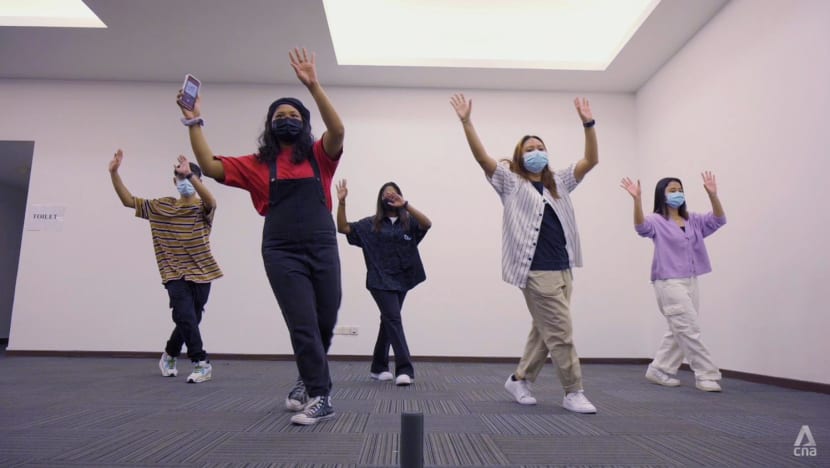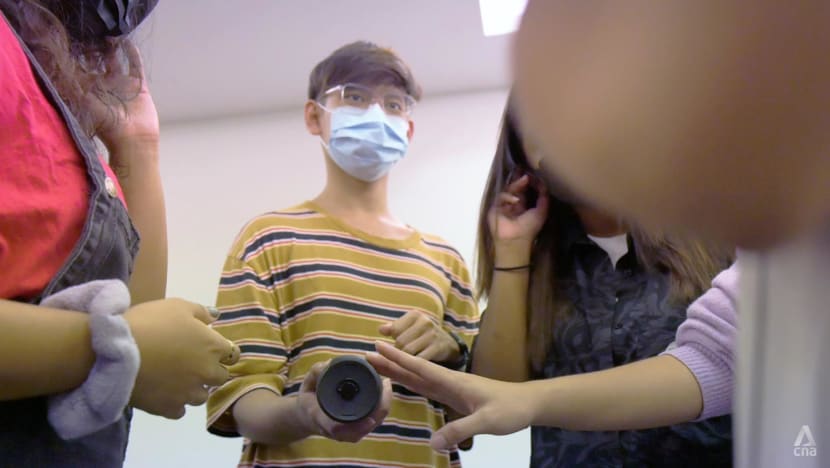These dancers are deaf but they love to dance. How do they hear music?
Redeafination, a dance crew made up of deaf dancers, was featured in the National Day Parade 2022 music video. As they demonstrated to CNA, learning to dance when you're deaf can be equally challenging and rewarding.

The Redeafination dance crew, made up of deaf dancers, was featured in NDP 2022's music video. (Photo: CNA/Try Sutrisno Foo)
SINGAPORE: Raising her hand in the air, 25-year-old Patricia Merilo grooved to the beat of the happy tune, flicking her wrist on each count.
Four other dancers from her dance crew, Redeafination, stood behind her, glancing at her wrist to help them keep pace.
Ms Merilo didn’t count aloud “five, six, seven, eight”, which dancers typically do to count down to the beat where they begin dancing. Instead, she let her hand gestures do the job.
When the song they’re dancing to, Stronger Together, the theme song for National Day Parade (NDP) 2022, finally hit its chorus, the five dancers busted out moves that had become muscle memory from participating in the music video.
Their movements were fast-paced to match the song’s tempo, and they remained synchronised throughout the two 8-counts that they demonstrated to CNA.
An average bystander would not have been able to tell that all five of them are deaf.

REPRESENTING THE DEAF COMMUNITY
Having been part of the NDP 2020 music video, as well as an active group in the dance scene since 2008, Redeafination is no stranger to picking up choreography.
While they started as a crew comprising a mix of hearing and deaf dancers, they are fully made up of deaf dancers today.
The group was founded by two hearing dancers with a passion for the deaf community. It all began with a dance workshop for the deaf, where any deaf person with an interest in dance could attend.
“It was then they realised there could be potential in the deaf community. But (they wondered) where there could be an accessible and safe space for them to develop,” Ms Merilo told CNA in a text message.
As deaf dancers, the Redeafination crew is also used to misconceptions and misguided remarks.
When people find out that their dancers are deaf, they’re usually “amazed” that deaf people can hear the music, shared 24-year-old Gan Jun Huan in a text message.
In fact, her crew mate, Sharifah Faaiqah Syed Abdullah Alkaff, noted that others tend to have misconceptions that deaf people don’t enjoy music. This is “not true as the majority of them love listening to music”, said the 21-year-old.
“The way we experience music is different from the way hearing people experience music, but we can still enjoy it in a full capacity,” added 22-year-old Lee Yong Cheong.
This lack of awareness about deaf culture in Singapore has only made Ms Sharifah Faaiqah happy and proud for representing her community in the NDP 2022 music video as part of Redeafination.
“It’s important to be aware of the deaf community, since sometimes there is no access for us. We're (also) human,” she said.
“We showed our sign language in the music video, because we wanted Singaporeans to know that Singapore Sign Language is our identity and our language. You can see how comfortable and happy we are signing.”

KEEPING UP WITH FAST BEATS
Still, there remain challenges in learning their dance moves, especially for a fast song. These would require far more time and practice to master.
“We work twice or thrice as hard compared to other hearing performers,” Ms Merilo told CNA with the help of a sign language interpreter.
Ms Gan added that she saw “huge differences” between hearing and deaf dancers when she had to dance with hearing dancers about five years ago. Coupled with a quick-tempo song, the pace proved to be a minor stumbling block.
“The deaf dancers need to count, for example, by tapping ‘five, six, seven, eight’, so that we can dance together. (The hearing dancers) were dancing too fast due to the fast beat music,” she said.
“I tried to count myself, however it didn't work for me because my moves were not the same as others. So I decided to follow others' moves without counting.”
With NDP 2022’s theme song too, the music initially seemed “too fast”.
As such, Redeafination had to make time to familiarise themselves with the beats and practise on their own after learning the choreography, in order to synchronise with the rest of the team without making any mistakes.

HOW THEY “HEAR” MUSIC
While it may not be evident that Redeafination’s dancers are deaf from solely watching them dance, it would perhaps be more obvious should one observe them learning to “feel” a song.
During their session with CNA, the five dancers gathered around a portable speaker and placed their hands on it to “feel and understand” the beat.
“Normally we go near the speaker when the environment is an open space and it’s quite noisy. But at training where we are in the studio, we don’t do that. We just blast the music out loud,” Ms Merilo explained.
“And whenever we have any performances, we usually make a special request for the main speaker to be in front of the stage.”
Doing this helps them to “hear” the music, she said.
“In order to hear the music, we hear the vibration of the floor and we internalise the beat and rhythm into our body. That’s when we establish the beat by counting, by clapping. So when we clap, we will feel the music,” she added.
“Once we understand the beats, we will try to apply them to our dance moves. Then we keep repeating the dance moves and blasting the music until we perfect our moves.”
Despite being able to follow alongside their hearing counterparts, they continue to be posed the same question over and over: How do you hear music?
And time and again, they provide the same answer.
"Music isn't just heard. It is felt," Ms Merilo signed.

















